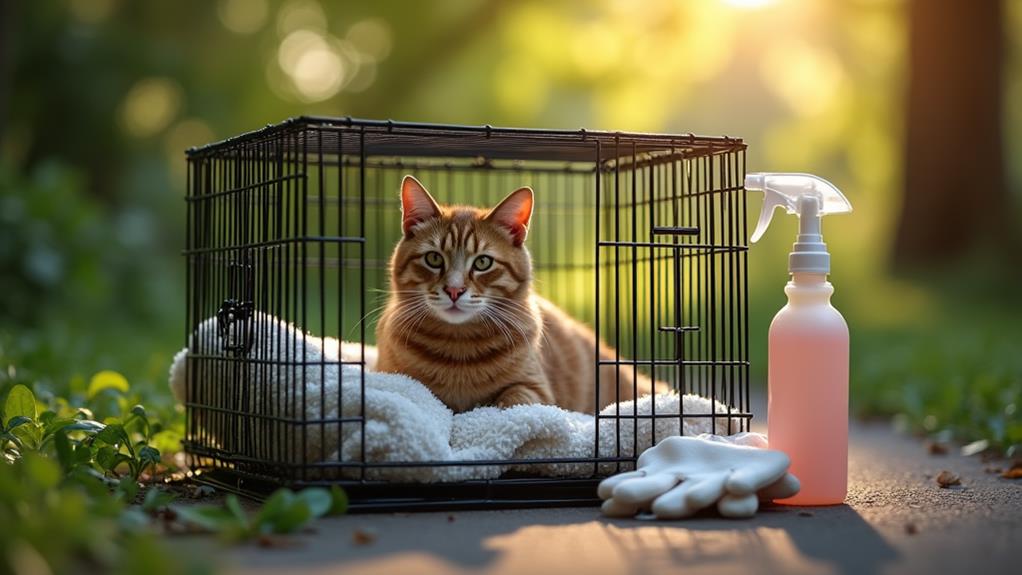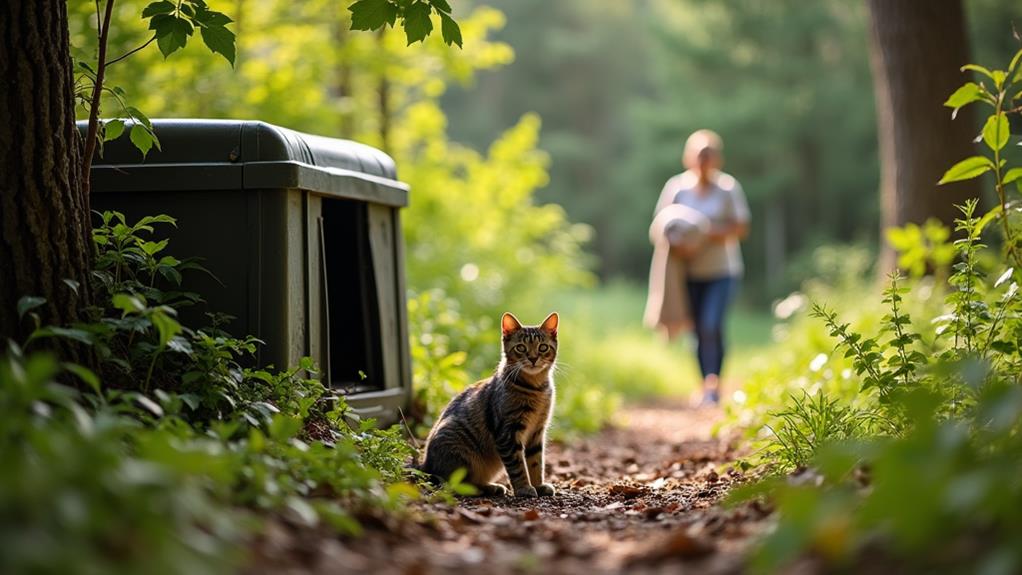How to Safely Catch an Injured Feral Cat: A Guide for Rescue

To safely catch an injured feral cat, observe its behavior initially and establish a regular feeding schedule to build trust. Use a humane trap with comfort padding, set in a quiet area close to its territory. Equip yourself with gloves and a calm demeanor. Bait the trap with strong-smelling food like canned tuna, and create a trail leading to it. After capturing, cover the trap with a blanket to reduce stress. Consult a community cat-friendly vet for immediate care and recovery planning. For more guidance on this delicate process, consider exploring further.
Understanding Feral Cat Behavior
Understanding feral cat behavior is vital if you're attempting to catch an injured one. Feral cats, often wary of humans, exhibit flight responses when approached, making it imperative to understand their behavior for successful trapping. They typically form colonies, influencing their social dynamics and behaviors, such as grooming and feeding habits. This insight aids in placing traps effectively for rescue efforts.
Communication is key when dealing with these cats. Feral cats use vocalizations and body language—like hisses, growls, and specific tail positions—to express stress levels or aggression. Recognizing these signals helps you gauge if they're feeling threatened or calm. During injury or illness, feral cats may become even more cautious and withdrawn, altering their usual behavior. You might notice reduced activity or changes in appetite, which are significant cues for planning your approach.
Observing their feeding habits and daily routines provides valuable insights. By aligning trap placement with their routines, you increase the chances of a successful rescue. Understanding their behavior not only helps in trapping but also minimizes stress for the cat, making your rescue efforts more humane and effective.
Preparing for the Rescue
Having gained insights into feral cat behavior, you're ready to prepare for the rescue of an injured feral cat. Initially, establish a consistent feeding schedule to build trust. This guarantees the cat visits regularly, increasing the chances of a successful capture. Gather necessary trapping equipment, focusing on humane traps and comfort padding. These assure the cat's safety and comfort during the capture, minimizing stress.
Identify a safe location for the trapping process. Choose a quiet spot near the cat's territory or favorite hiding spots, reducing distractions and making it feel secure. Before attempting the rescue, consult with a community cat-friendly veterinarian to discuss the cat's condition and any specific capture care needs. This will help you better understand the required post-capture care.
Plan a recovery space in advance. Confirm it's comfortable and secure, providing a tranquil environment for the cat's post-treatment healing. This proactive step also helps minimize any last-minute stress. By preparing these elements, you create a safer and more effective rescue plan, assuring the injured feral cat receives the care it needs in a compassionate manner.
Selecting the Right Trapping Equipment

When you're gearing up to catch an injured feral cat, selecting the right trapping equipment is crucial for a successful rescue. You'll want to opt for humane traps specifically designed for cats. This guarantees they're in good condition and the appropriate size for the cat you're targeting. Larger traps can be advantageous for wary cats, as they provide more space, reducing stress and enhancing your chances of a successful catch. Among the best options, Drop Traps are highly effective, especially when dealing with difficult-to-trap feral cats. To optimize their efficiency, set them on flat ground and use proper camouflage.
While setting up your trapping equipment, make certain each trap has comfort padding. This diminishes discomfort for injured cats during the trapping process, making it a more humane approach. Regular maintenance is key, so inspect and maintain the equipment often to prevent malfunctions and guarantee the safety and comfort of the trapped cats.
Here's a quick checklist for your trapping process:
- Use humane traps with comfort padding.
- Consider larger traps for wary cats.
- Regularly maintain and camouflage traps.
Effective Baiting Techniques
Bait is your secret weapon when trying to catch an injured feral cat. Using strong-smelling food like canned tuna or sardines is vital to attract these elusive animals into your trap. The scent of these foods is irresistible to many feral cats, increasing your chances of success. Begin by creating a food trail leading to the trap. Place small pieces of bait along the way to guide the cat to the trap's entrance. Make sure that the main bait is positioned at the back of the trap so the cat has to enter fully to reach it.
It's important to remove any nearby food sources to make the trap more enticing. Experiment with different types of bait since preferences can vary; some cats might favor sardines over tuna. Once you've set up the trap, monitor it frequently. This allows you to refresh the bait before it becomes stale, maintaining its effectiveness in luring the cat. Be patient and observant, as feral cats are cautious by nature. Regularly checking on the trap guarantees that you can adjust your baiting strategy as needed, increasing the likelihood of safely capturing the injured cat.
Safe Trapping and Handling

To secure the safe trapping and handling of an injured feral cat, use humane traps specifically designed for felines. Confirm these traps are in good condition and appropriately sized for the wary feral cat. Set them in quiet, protected areas where the cat feels safest, ideally near known feeding spots. This strategic placement increases the chances of successful capture while minimizing stress for the injured cat.
Once the trap is set, it's essential to monitor traps frequently, ideally every 30 minutes. Quick checks help minimize stress on the cat and allow for timely transport to the veterinarian once the cat is captured. After trapping, immediately cover the trap with a blanket or towel. This simple step helps reduce stress and anxiety during the transport process.
Always wear gloves when handling traps and cats. This precaution protects you from potential bites and scratches. Approach the traps with a calm demeanor to avoid startling the cat, confirming a smooth process.
- Use humane traps designed for cats
- Set traps in protected areas and feeding spots
- Monitor traps every 30 minutes
These steps will assist in the safe, humane capture and handling of an injured feral cat.
Veterinary Care and Recovery
After successfully capturing an injured feral cat, promptly consult a community cat-friendly veterinarian to determine the severity of its injuries and to establish a treatment plan. Veterinary care is critical for addressing the cat's immediate health needs, regardless of whether it involves medication, surgery, or other interventions. Discuss necessary vaccinations and the possibilities of spaying/neutering with the vet, as these are fundamental for managing health and population control.
Once you've addressed the initial treatment plan, prepare a recovery space that's quiet and secure. This environment is essential for minimizing stress and aiding the healing process. Confirm it's away from other pets, providing the injured feral cat a peaceful area to recuperate. Utilize in-trap care guidelines if needed, making sure the cat remains comfortable and safe.
As the cat begins its recovery, monitor it closely for signs of complications or distress. Check if it's eating and drinking appropriately, which are critical indicators of its recovery progress. Follow post-treatment care instructions from the vet to facilitate a smooth healing process. By providing attentive care and a calm recovery space, you'll greatly contribute to the injured feral cat's successful rehabilitation.
Ongoing Community Support

Community involvement plays a crucial role in sustaining efforts to help injured feral cats. By engaging local community members, you foster a supportive environment that encourages collective action for the welfare of these cats. Establishing a network of dedicated volunteers can streamline trapping, veterinary care, and rehabilitation processes, making your rescue efforts more effective. Regular community meetings are fundamental for raising awareness about feral cat issues, allowing members to share resources and best practices.
Here are some ways to improve your community support:
- Collaborate with local animal shelters and rescue organizations: This can provide access to supplementary funding, veterinary support, and educational resources for effective feral cat management.
- Promote responsible pet ownership: Educate the community on the importance of spaying and neutering pets to reduce the number of stray and feral cats, easing the burden on rescue efforts.
- Host educational workshops and events: These can increase public awareness and engage more community members in the cause.
Collaboration is key. By working together, you can create a network that not only supports feral cat rescue but also promotes responsible pet ownership. Your efforts will lead to a healthier, more humane environment for all.




